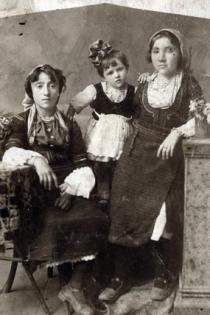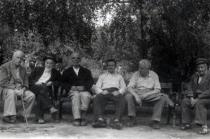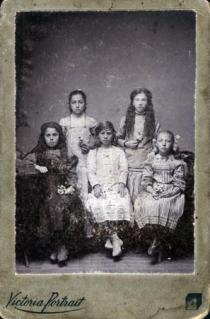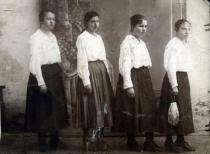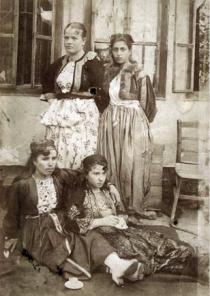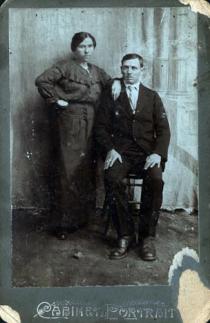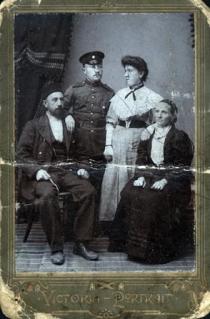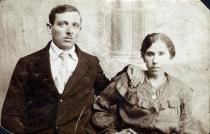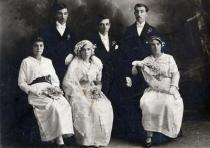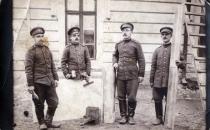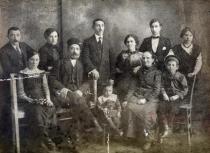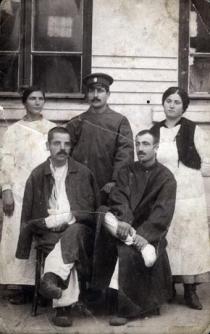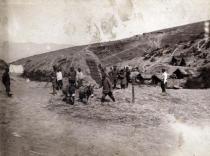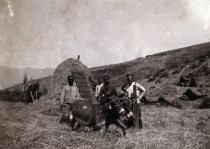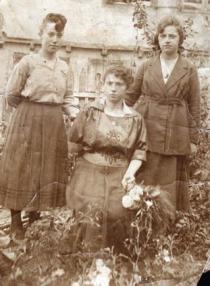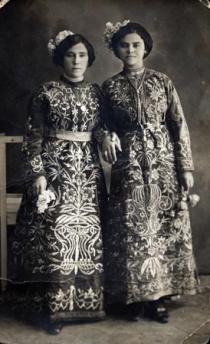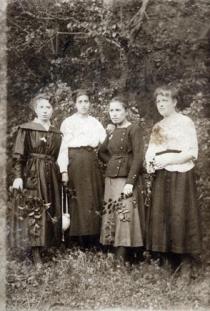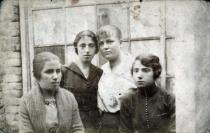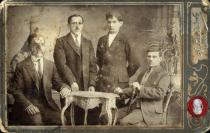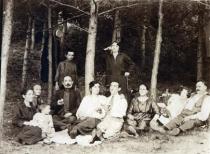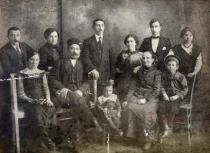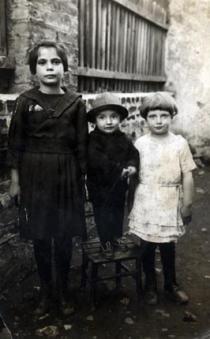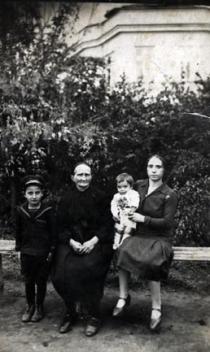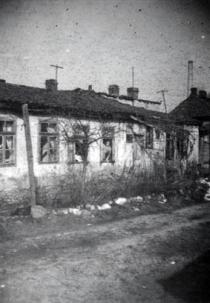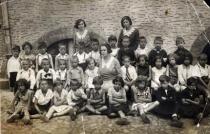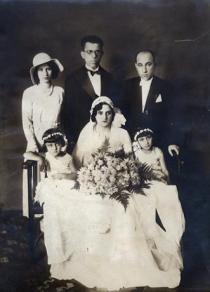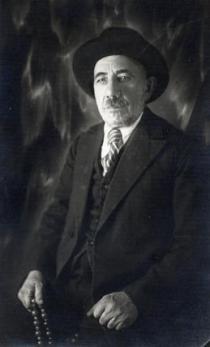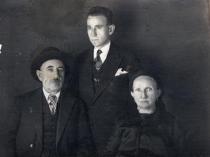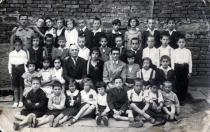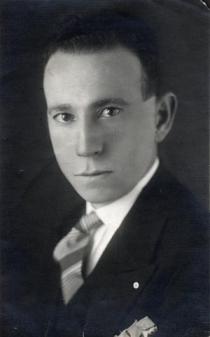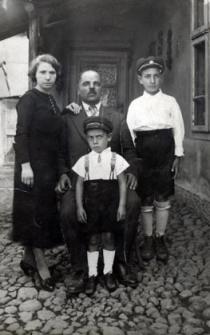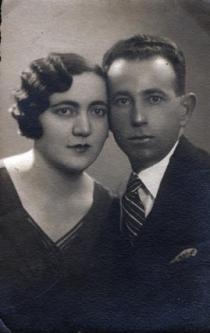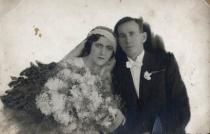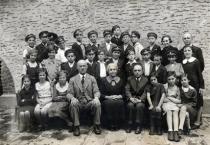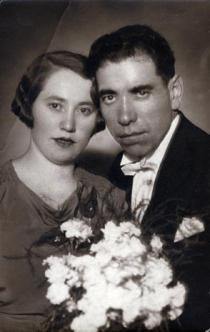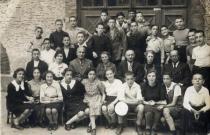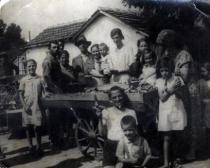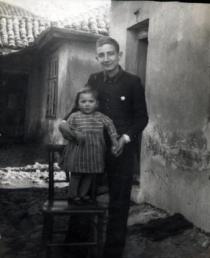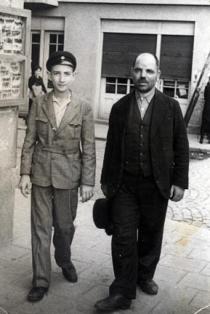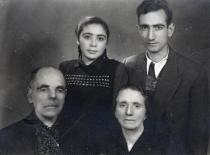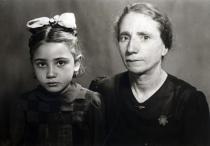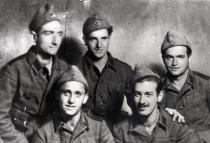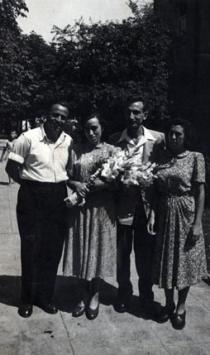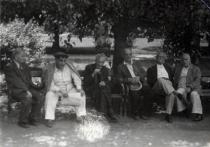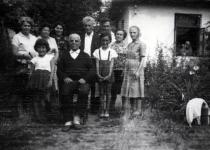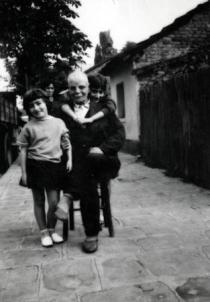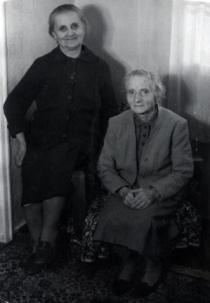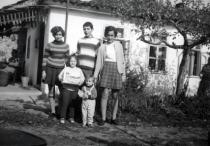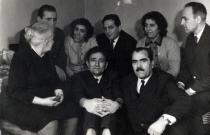
Sofia
Bulgaria
Interviewer: Dimitar Bozhilov
Date of interview: June 2005
Nissim Kohen views himself as a typical representative of the Jews from Iuchbunar 1. He spent his childhood and adolescent years there, surrounded by large families of relatives. He feels responsible to tell the events from his life precisely and in detail. He lives in a cozy, modern flat in a block, which was built on the site of the house he was born.
I am convinced that my ancestors came from Spain 2. I suppose that at first they settled on the territory of former Yugoslavia and later they came to Bulgaria. I do not have any concrete information on that, these are my conclusions. Unfortunately, there is no one to ask about that now.
I suppose my paternal grandparents Nissim and Amada Kohen were born in Sofia. It is interesting that they were first cousins. That was allowed by the Jewish tradition. They lived in the Jewish neighborhood in Sofia – Iuchbunar. Most of the Jews lived there. I also come from Iuchbunar.
My grandfather's house was on 12 Slivnitsa Street. Later the street was renamed to 7 Gyueshevo Street. Our house was made of adobe and at first it had only one room and an entrance hall. Later another room was added as well as another extension, which was the house of my uncle Rafael Kohen. My father's elder brother Eliya Kohen also lived in that yard. His house was the most solid one. My father Mihael Kohen took a half of one of my grandfather's rooms and enlarged it. He also built another room with a small entrance hall where he lived with his family. There were some inconveniences. The toilets were outside and we had no running water inside. There was a tap on the street, which we used. We had electricity. Later we had running water in the yard, but not in the house. The street, on which we lived, became all muddy when it rained. And so did most of the streets in the Jewish neighborhood.
My grandfather was a leather worker. He had a small workshop in the center. He made shoes of calf and horse hide called 'opintsi'. Those shoes were low and shallow. They were closed and were made of processed or unprocessed leather. They were pointed, the color of the leather and had shoelaces. Our grandfather's kin was called 'los konyos'. This is a combination of Bulgarian and Ladino 3. It means 'people who work with horses'. My grandfather and uncle Eliyah bought horse hide, tanned it and sold it. That's how their nickname appeared. My grandfather had a small beard and he wore a hat. He was fair-haired and a little stooped. He was a wise man and his word was respected in the family. We spoke to him in Ladino. My grandmother was always ill and rarely went out of the house. Sometimes she stood on the doorway in the yard or in front of the house. She was a wise woman with a very good memory. She knew a lot about many people, although she stayed mostly at home. My parents looked after my grandparents. My mother did all the housework.
My father had three brothers – Eliyah, Rafael and Azarya Kohen. The eldest one, Eliyah Kohen, was a cobbler. The next one, Rafael Kohen had a workshop for mending shoes in the center of the town. He took to drinking and lived very miserably. Before going home, he would stop in a pub and since he was in much debt, he had to get home using less traveled roads so that he would not meet any of the people whom he owed money.
Later he moved his workshop in our house. The third brother of my father Azarya worked as an adolescent for the Arie family 4 in Samokov 5. That was a rich family, whose house is now a museum. The Arie were in the leather and the banking business. My uncle was a leather worker. He worked for free, because my grandfather had taken money from them to build his house. There my uncle learned the craft and decided to start a leather business by himself. He also lived in the Jewish neighborhood on Shar Planina Street and Tri Ushi Street. I had a lot of cousins in Sofia. There were nine children in the families of my uncles who lived in our yard. Uncle Eliyah had four children – Mindusha, Moshe, Sofka and Hemda, and uncle Rafael – five – Buka, Simanto, Nissim, Elazar and Milka. Uncle Rafael married Buka-Miriam (nee Toledo) who was from Provadia 6. Uncle Azarya had a girl – Hemda, who lived and died in Sofia. His wife's name was Buka, nee Konfino and was born in Shumen 7. My father Mihael Kohen tried many things in life. He spent eight years in captivity during World War I 8. He was held captive by the French army near Salonika (Greece) as a soldier from the Bulgarian army. After that he worked as a tinsman. He took part in the construction of the roof of the first building of the Sofia University 9. He traded with second-hand products. Later, together with an uncle of my mother's Chelebi Haravon, and with the active help of my uncle Mois Haravon, he managed to set up a haberdashery on Lomska Street [present-day George Washington Street, near the central Sofia synagogue], but those were the years of the great crisis 10 in 1929-1932 and he was forced to close it down. Then he started work as a street vendor and walked around the neighborhood with a tray selling elastic cords, tights and haberdashery. Then he made a warehouse selling coal near our house. At that time people could not afford to buy a lot of coal and came to buy 5-10 kilos. In this way my father was able to support us and helped the people in the neighborhood. That continued until the passing of the anti-Jewish laws 11 when he was forbidden to work.
My mother's kin comes from Kyustendil. My mother's parents Yuda and Bohora Haravon lived there. I went there every summer when I was a student in the first grades of the Jewish school. My grandfather was a tinsman and my grandmother – a housewife. My mother's kin is very large. She had six brothers – Yosif, Rahamim, Shimon, Nissim, Chelebi and Mois Kohen. What is interesting about them is that my grandmother's parents left as early as the beginning of the 20th century, around 1906-1907 to the blessed land (Palestine at that time) to die there. They left their lands, their children and set off. My mother Sarina Kohen was 8-9 years old then. As far as I know my grandparents have graves in Jerusalem.
There were a lot of Jews in Kyustendil. They had their own synagogue and a community house. My grandparents lived in the Jewish neighborhood, which was around the synagogue. I remember that they lived in a small house, which had a ground floor and another floor. A relative of my grandfather's lived on the ground floor. His name was Manoah, and on the next floor lived my grandfather's family and my uncle Isak Haravon.
My maternal grandfather had two sisters Reyna Elazar and Sara Elazar, who had many children. They both adopted the family name Elazar after they married, but I do not remember if their husbands were relatives. Both sisters were very different. Sara was more talkative and funny and the other one was stricter and more aristocratic. My grandfather was the eldest. He was a silent, but a pleasant man.
My mother had four brothers – Buko-Aron, Chelebi, Mois and Isak Haravon and two sisters – Sofi Haravon and Victoria Eshkenazi. The eldest one, Buko-Aron Haravon was a shoe merchant. He lived in Sofia and died in 1951. His wife is from Sofia and her name is Matilda. They had two daughters – Liza and Bienvenida, who was killed in 1944 as a partisan. Chelebi Haravon was a tinsman and sold coal. He moved to Sofia, where he opened a warehouse for combustibles. His wife was born in Sofia and her name was Buka. He died from apendicitis in February 1938. They had three children – Leon Haravon, who was killed as a partisan, Sofi Mayer, who left illegally for Palestine in 1945 and Nissim Haravon, who died in Israel. He was a composer. Mois Haravon was also a merchant. He went to Sofia when he was young. In 1930 he married his wife Roza Katalan, who is from Sofia. They left for Israel during the big aliyah 12. They have two sons – Leon and Gavriel, who live in Israel. My mother's youngest brother Isak Haravon, was an electrical technician. He lived mostly in Kyustendil. He was a fan of Tolstoy 13 as regards moral and character. He did not drink and he was a vegetarian. His wife's name was Matilda, nee Benaroya, and she was born in Berkovitsa. They left for Israel. They have two children – Ida Levi, who was a housewife and Yeuda Haravon, who worked as an electrical engineer. Isak Haravon and his family lived in Ramat-Gan. One of my mother's sisters Sofi died very young while giving birth. About her I only know that she married a Jew from Botevgrad [a town in northwestern Bulgaria]. My mother's other sister Victoria Eshkenazi, married in Sofia. Her husband's name is Gershon Eshkenazi and he was born in Ruse. She was a housewife and her husband worked in the enamel factory [factory, producing dishes for Sofia]. They moved to Israel and she died there. She did not have any children.
My parents met in an interesting way. During World War I or probably at the end of the war, my uncle Azarya Koen was injured and was sent to the family of my mother in Kyustendil to be looked after. There he decided that my mother would be the perfect for wife for his brother, my father. After the war ended and my father returned from captivity, his brother Azarya told him that he had found a very nice girl from Kyustendil for him. My father retorted that he did not need a wife and Azarya should marry her if he liked her so much. But his brother was already married. There were other attempts to bring them together at that time. But in the end, they met by accident when my mother came from Kyustendil to visit her brother Buko Haravon. Later it turned out that she was the girl that uncle Azarya was talking about to my father. They liked each other and got married. Their wedding was in 1922 in Sofia. In my family my mother did all the housework and she helped my father who had a warehouse for coal near our house.
My mother had graduated primary school and started studying in a vocational school, which she did not finish due to lack of money. She kept her notebooks from the vocational school for many years. They contained sewing designs, which can be drawn only by a professional designer nowadays. My mother had a hard life. She had two more boys after me, but they died. My first brother Leon was born in 1927 but he died of diphtheria in 1933. In 1929 my second brother Albert was born. He died in 1934.
My mother got seriously sick of typhus. At that time Leon, my younger brother, and I were sent to my grandmother's house in Kyustendil and my father took care of my mother at home. When she was pregnant with my sister in 1937, my mother had a serious appendicitis crisis. A surgeon from the Jewish hospital in Sofia 14 came and ordered them to transport her to Sofia for an operation. My father made a stretcher out of blankets and with the help of the neighbors we transported her to the hospital, where she underwent an operation. Some months later my sister Sofi was born. In the beginning of 1938 a lot of people close to my mother died – firstly, her brother Chelebi and then her mother, who had come for the funeral of her son. Then in the summer of the same year her father died. The same year, 1938, I got very sick of acute typhus and was admitted to hospital. While I was in the hospital, there were the so called 'blockades'. Streets were blocked by soldiers and no one was allowed to go out. Those blockades were set up when governments were replaced and when there were serious changes in the power structures. They lasted for a couple of days. Blockades were also set up when illegal people were searched for. I do not remember the reason for the blockades when I was in hospital. Then my mother stood up to the soldiers and wanted to come and see me in the hospital but she was not allowed.
On Friday evening and Saturday morning my parents and especially my mother went to the synagogue. There was a midrash near us. [Editor’s note: There is no exact data on the number of midrash in Sofia. That midrash must be the Iuchbunar synagogue where rabbi Daniel Zion organized meetings.] My mother went to the meetings organized by the rabbi Daniel Zion 15 who had a very high reputation, encouraged charity and taught the Talmud.
My mother was clever and hard-working. She read books in Ladino. I think she got the books from acquaintances. At home we had Bulgarian literature, which we took from the community houses. There was a Jewish community house on Klementina Boulevard [present-day Stamboliiski Blvd] and on Lege Str. I also took books from the Bulgarian community house on the corner of Tsar Simeon Str. and Bregalnitsa Str. Its name was 'Hristo Botev'. Thanks to my mother I learned to read a little in Ladino in Rashi. She had a beautiful handwriting and expressed herself very well. Her Bulgarian was also very good. Uncle Mois Haravon also expressed himself very well. He wrote to us very good letters in Bulgarian from Israel.
Our neighbors in Sofia were mostly Jewish families. On our street 'Gyueshevo' there were Bulgarian families too. Most of the people were traveling salesmen and Bulgarian families. There were a number of grocery stores, some barber shops, cafes and pubs. Iuchbunar was like a hotel for many people. They came here only to spend the night and spent all the day working as salesmen, or workers in factories and tobacco warehouses. Almost none of the Jews in Iuchbunar worked as clerks on a state or municipal position. I do not remember knowing such Jews, except for a cousin of my father's who became a director in the Bulgarian Post. I started work as an electrical technician, but after an illness I experienced, I started work in a trade company. After the adoption of the anti-Jewish laws I went to work in the enamel factory producing dishes.
My father and his brothers were not members of any Zionist organizations but they had their political affiliations. My father voted for the left political formations – mostly for the socialists. I know that at some time the famous general Lazarov ran for a deputy. During the Balkan war and World War I the general was a commander of a regiment including many Jews. They worshiped him and he expected to receive wide support from the Jewish neighborhood. My father always spoke about him with pleasure and love. But the general did not manage to gather enough votes.
The Jewish rites were strictly observed. We did not mix milk and meat meals. At home we had separate cutlery for meat and for milk. We also had separate dishes for Pesach. Before the holiday we cleaned the house thoroughly and whitewashed the walls. The children received presents. Presents were also made on Purim and Rosh Hashanah. On Yom Ashekel there were marches and money was raised for the Jewish National Fund. On that day all Jewish organizations gathered on the streets around the Jewish school in Iuchbunar. I remember that there were arguments whose flags to be first during the march. It started from the Iuchbunar school, passed along Klementina Str and reached the center somewhere around Lege Str. All members of Jewish organizations were dressed in the respective uniforms. They sang songs in Ivrit and Maccabi had a brass orchestra and drums. A lot of Jews took part. One street was not enough for us all. After the march the children went to play sports games in the yard of the Jewish school and the adults went to a meeting in the Jewish People's Home. The Jewish National Fund was a structure of the World Zionist Organization of Chaim Weizmann, Max Nordau etc. In August 1937 I had my bar mitzvah. I made a promise with a speech towards my parents. While the other children had the speech made by a chazzan or a rabbi, my speech was written in Bulgarian by the Ivrit teacher in the Jewish school Mr. Benmair. The bar mitzvah was done at my uncle Azarya's place. A lot of guests with many presents came. My grandfather was still alive and was also present.
When my grandfather was still alive, on Pesach we gathered in his room together with my father's four brothers and their families. The table was long. On one of its sides there was a minder (a low and long bench) and on the other side there were chairs. 20 people could sit on that table. In the middle of the table we placed the three boyos [special unleavened bread without salt] and a plate with seven meals and the so-called ‘charoset’ [mixture of nuts, fruit, wine and other ingredients for the Pesach ritual, which represents the mortar used while in slavery in Egypt], which was made of apples, honey, walnuts and maybe dates. At first, we performed the ritual of washing the hands. The women presented a basin to my grandfather and to us all to wash our hands. Then we drank a glass of wine. My grandfather drank a little wine and read the prayer. We accompanied him. One of the boyos was broken in half and put in a towel, which the children carried on their backs to show that they were leaving to Israel. The food was festive. There was usually soup of matzah and boiled hen. The matzah was dipped in egg and placed in the soup to boil for a while. Another typical dish on that day was leaks balls.
In Sofia, especially for Pesach, one or two bakeries were hired and after they were meticulously cleaned, they were used to make matzah and boyos. Boyo was different from matzah. While matzah had a tiny crumb, boyo is round and looks like a thick bun. It does not rise, because it does not have yeast. There was a period, when only matzah was made in the bakeries and my mother tried to make boyos at home. Boyos were very hard and we called them 'brick'. What was left from the boyos after Pesach was used as rusk. It was delicious dipped in tea or eaten with cheese.
Hens were bought alive from the market and brought to the shochet to be slaughtered. There were two places where hens were taken. The first one was at the central synagogue and the other one – at the Iuchbunar synagogue. Later, after 9th September, when there was no longer a schochet, my parents asked a neighbor to slaughter the hen. Another typical dish for Pesach was burmolikos 16, which were made of matzah and eggs. They were sweet or salty. At home the sweet ones were dipped in sugar syrup or covered with powdered sugar. It was usual for Pesach to put lettuce on the table. We ate matzah or boyo for eight days.
On Purim the Jewish school organized a fancy dress ball. The Jewish school had a very good choir led and conducted by Mr. Aladgem. The famous opera singer Mati Pinkas started from this choir. I remember a school celebration of Tu bi-Shevat. The whole school gathered in the gym together with the children's parents. There were a lot of songs, the tables were covered with fruit, there were many people.
The so-called 'buying off' was typical for Jewish families. If a large family had only one boy and a lot of girls or vice versa, the boy could be bought by one of the relatives. That is 'el mercado' in Ladino, meaning 'bought'. That was done to save the life of the only one. The relatives who had bought the child, received presents on Purim. A nice tray with a small present was prepared – some sweets or masapan and it was presented to the one who had 'bought' you. And that person bought shoes and clothes for the child. I was bought by a relative – Hemda Kohen, who is daughter of uncle Azarya Kohen, and my mother had 'bought' a neighbor on our street.
There was a tradition among Jews, similar to fooling fate. When there was someone seriously sick, the chazzan went to him and if his name had been Avram, he received a new name, for example Nissim. The reason for the new name was that if the man was sentenced to death as Avram in the 'list', he would be saved with his new name. And sometimes it worked. An aunt of mine, wife of my uncle Buko Haravon, Matilda Haravon, had her name changed. Nevertheless, she did not recover, and died soon after that.
Jewish traditions were strictly observed in our family. On Sabbath my father did not go to work. My mother did not light a fire and prepared the meals on Thursday or Friday. According to the Jewish tradition you are not allowed to work and should not allow your cattle or your slave to work on Sabbath. Sabbath is for all. In the winter when it was very cold my mother cleaned the stove and filled it with coal. Then she asked a neighbor who was not a Jew or a passer-by to come and light the fire.
On Pesach we played with walnuts. The girls arranged two or three heaps of walnuts and aimed at them from a distance. They won the heap that they managed to hit. The boys also played a game with walnuts. We made a small hole in the ground next to a wall and we threw walnuts in the hole. The walnuts which landed in the hole were won by the boy throwing them. There was one more game with walnuts. Every boy received two-three walnuts. They formed a line and tried to hit other walnuts placed on the ground with theirs. If they managed to hit a walnut, they won it.
At home we never ate on [Yom] Kippur. While I was a child, that rule was more strictly observed. When I grew up and started learning things, it was not so strict. We had a saying that 'the Jewish child becomes worse when growing up'. On [Yom] Kippur we went to the Borisova Garden where we rowed boats. Mati Pinkas sang a very nice song 'Oh, Jerusalem nights' in the evenings there. During the day on [Yom] Kippur the children took a quince, sprinkled it with clove and smelled it all the time not to feel hungry.
On Purim children put on fancy dress clothes and went from house to house. They sang songs, told poems and received money. We used what we could to make masks. Some children turned the inside of their coats out, others wore their pajamas. There was a song sung in Ladino 'Last night I ate cheese pastry and my tooth fell. Give me money, to fix my tooth.' That was a joke song.
We celebrated Chanukkah. We did not have candlesticks. Then we used float lights. In a glass bowl filled with oil, we placed paper with a small hole in the middle. We pushed a wick made of cotton through the hole. One of the cotton ends was in the oil and the other end was lit. We made ten such bowls. Every day we lit one of them. We made the candles for Sabbath in the same way.
There were around 10 praying homes in Sofia. There were societies, which took care of the funerals. [In the 1930s there were a lot of Jewish charity societies such as 'Kupat Tsedaka and Bikur Holim', 'Moasim Tovili', 'Malbish Arumim'. There were also religious and funeral ones – 'Chevra Kaddisha', 'Oavim and Orhot Haim'.] They were at a synagogue which was on Bregalnitsa Str. There were the so-called midrashi next to our house. They were small praying homes for around 30-40 people. My father visited such a praying home on Odrin Str.
There were two Jewish schools in Sofia. One of them was in Iuchbunar on Bregalnitsa Str. and Pozitano Str and the other was in the center of the town. There was a synagogue next to the Jewish school in Iuchbunar. For a time while we were students, we went to the synagogue in the neighborhood on Saturdays to pray. The adults went from 9 to 10 am and we went after them. We were in junior high school then and prayed separately from the adults.
I studied in the Iuchbunar school. I also went to nursery school. We started studying Ivrit in the nursery school. We learned songs and fairy tales in Ivrit. In the first grade we had a teacher who taught us reading, writing and maths in Ivrit. We also studied Bulgarian. Until the fourth primary grade we studied all subjects, such as reading, writing, botanics, mathematics etc. in Ivrit. We studied in the mornings and the afternoons. The classes were mixed. Our classes were from 8 to 12 and from 14 to 17. We also had physical education. After the fourth primary grade, in the junior high school grades, all subjects, except the Jewish ones, were in Bulgarian. The Jewish subjects were learning the Torah, Jewish history and Jewish literature. We had both Bulgarian and Jewish teachers. We also had teachers from abroad. Those who taught Ivrit were mostly from Poland and Russia. Our teachers were very good, but they were not well paid. I remember that they were on strike once for not receiving their salaries. The salaries were provided by the Jewish municipality.
From first to fourth grade our Ivrit teacher was Ashrieli and our maths teacher – David Pilosof. Then, in the higher grades I remember Mr. Dembovich, teaching Ivrit, Torah and Jewish history, Benmair – in literature and grammar, Mr. Temkin – in Torah and Jewish history. Mr. Temkin also taught in the central Jewish school.
Jewish schools were the so-called 'private schools' and that is why after the third junior high school grade [present-day seventh grade] we had to sit for an exam in front of a commission formed by the Education Ministry. For a couple of months we had to revise and learn well everything we had learned in Ivrit from first to fourth primary grade so that we would be able to talk about it in Bulgarian in front of the commission. We were very well prepared in Bulgarian language and in maths. In our class 19 of the 30 students received excellent marks. I remember that even the newspapers wrote about our success. It was thanks to our teachers and to the fact that there was a natural selection among the students through the years. What was typical about Jewish schools was that in the first grade we were three or four classes and until the last junior high school grade only one remained. There were many reasons for that. Firstly, it was hard to study in the Jewish school because of the language. Secondly, education was all the day. All the other schools studied until one o'clock in the afternoon but we studied in the mornings and in the afternoons. Thirdly, many of the people in the Jewish neighborhood were poor and wanted their children to start working from an early age in order to help the family. So, some of them were sent to Bulgarian schools, and others were sent to work.
The Jewish school was between Osogovo Str, Bregalnitsa Str and Pozitano Str. There was a synagogue complex on a part of Pozitano Str. There were two yards. The Jewish school had two buildings – a new one and an old one. The nursery school, first and second primary grade were in the new one and the other classes were in the old one. The new building was opened in my time – approximately around 1930. I was among the first students who entered it. What was typical for the times was that the children living in the center of Sofia near Hristo Botev Blvd studied in the central Jewish school. The other children studied in the Iuchbunar school. The classes consisted of 35 to 37 children. But gradually that changed and children from Iuchbunar went to study in the central school, because the number of children there was declining. Some of my classmates had to move to the central school in the last grades. There were three classes in the nursery school, and there were 35 – 40 children in each one. There were at least three classes in the first grade. The number of students in the classes declined throughout the years and in the last junior high school grade there was only one class of 35 students.
A lot of the subjects in junior high school [three grades after the four primary grades] were in Bulgarian. Zoology, anthropology, physics, chemistry and maths were in Bulgarian and Jewish literature, Jewish history and the Torah were in Ivrit. We graduated junior high school in third grade, which is equivalent to present-day seventh grade. We had various teachers. Most of them were very talented. Our music teacher Aladgem later became famous as the conductor of the Army orchestra. He did his military service in the King's Symphony Orchestra and in the school he was replaced by the artist Yosif Yosifov, who also became famous later on. We had very good teachers. We had a maths teacher Nikola Shopov. Unfortunately, he did not teach me, but everyone spoke about him with veneration and they said that after he died, his brain would be given to research because he was extremely clever.
We had a lot of fun at school. Once a rabbi from Serbia came and wanted to organize a choir at the synagogue. But he did not know Ivrit. We were already members of Zionist organizations and we tried to talk in Ivrit. That man got into very funny situations with his bad Ivrit. Instead of asking us 'Are you in the choir?', he would ask 'Are you in a hole'. In Ivrit 'choir' means 'a hole'.
I learned Ivrit at school. We studied the Torah, Jewish literature and history. We were obliged, but also willing to talk in Ivrit. My parents knew only a few words in Ivrit. My mother knew more than my father because she had studied four grades in the Jewish school. She could read in Ladino in Rashi. She read books in Ladino.
I graduated high school in 1938. In 1937 the son of King Boris III 17 was born – Simeon II 18 and then all our marks at school were raised one point. No one was expelled for bad marks. There were also students who received the mark of 7 [6 is the highest mark in Bulgarian schools.]
The Jewish school was the focus point of all Zionist organizations. Those were Hashomer Hatzair 19, Betar 20 and Maccabi 21. Other organizations such as Akiva and Akara gathered in the Jewish People's Home. I was a member of Hashomer Hatzair. All organizations educated their members during meetings, marches, gymnastic exercises. In Hashomer Hatzair they focused on scouts education, cultural activities and preparation for leaving to Israel as pioneers in the new country. In Maccabi they focused on exercise and Betar – on military discipline. There were neverending disputes between the members of these organizations.
Before Hashomer Hatzair I was a member of Maccabi, when I was a student in third or fourth primary grade. Soon after that our whole group transferred to Hashomer Hatzair. We were there until 1941 when Jewish organizations were disbanded and then I became a member of the UYW 22. Hashomer Hatzair was a left scout’s organization. It was an educational organization characterized by a love of nature and freedom. Once or twice every week there were meetings of the boys' groups, the girls' groups and the mixed groups. There was a group uniting the members at a certain level of development. That level was defined by age – children, students and adults. During the meetings we discussed books and exchanged information on many topics. We discussed a famous book at the times 'Discussions with a philosophy teacher' by Trachtenberg. That is a German author, whose book was on Marxism. The discussions were in Bulgarian. We played Kuntsovi games – in quickness of wit and guessing. [Interviewer’s note: He says that they called the games 'kuntsovi'. He cannot explain the name. Would that be 'kunst' games? I suppose it might come from German – kunst meaning art in German. Also, there are some tests and theories in psychology – it might be one of them.] For example, we had to guess the object by its smell or its sound – for example, whose watch was ticking. We also played games in nature – searching for tracks and uncovering hidden objects. In the summer mountain camps were organized, the so-called 'mashabot', I went to Tsigov Chark area in the Rhodope Mountains. The Hashomer Hatzair members had a uniform. It was with a different tie depending on the level of development. The green tie was for the children, the blue one – for the adolescents and the black one for the adults. Each group had its flag. The organization in Maccabi was similar. But they put more focus on exercise. Their uniforms consisted of white blouses and black trousers. Betar and Hashomer Hatzair had different views on what kind of state Israel should be. We advocated for a mixed binational state, cultivation of the land, development of agriculture, while they advocated winning the land with a weapon in hand. They sang a song about the Jewish state on both sides of the Jordan River.
Hashomer Hatzair considered itself a more leftist, younger-oriented and more vigorous organization than the others. The meetings took place in the building of the Jewish school after classes. There we also played people's ball and volleyball. It was a leftist organization and that is why it was close in ideas to the UYW. That is why, sometimes the Jewish municipality did not allow Hashomer Hatzair to stay in the yard of the school. Then we met in some park – usually the town's park. Later, around 1938 the organization opened its own club on Klementina Str (present-day Stamboliiski Blvd) at the streets Osogovo and Stara Planina. Now that location is changed and the old buildings do not exist any more.
Political issues were seriously discussed in Hashomer Hatszair. There was the so-called 'Court of War'. That was in the beginning of 1939. Each of us took the position of a certain party in a conflict, which was controversial at the time and we discussed the issues of war and peace. I represented China, others represented Germany or Russia, England, France. Everything was like a game. We invited all members of the organization and we sat on a table in front of them as judges, prosecutors and defenders. The idea was to defend peace and condemn war.
In Hashomer Hatzair we raised money for the Jewish National Fund 23. There were different ways to raise money. One of the ways was on Purim, another – in the synagogue during a wedding. A third one was on Yom Ashekel. On Purim a group of people went from house to house of Jewish families with blue and white money boxes to ask for donations, with which the Jewish National Fund bought land. Most of the people in Iuchbunar were not rich. We did not know where to go and knocked on three or four doors. It was harder with the blocks of flats outside Iuchbunar. But we looked at the family names on the doors and knocked only on those with Jewish names. In this way, we raised a little money. There were also funny moments. We made jokes with the expression 'The missis said she was not at home' – that is, there were cases when a maid opened the door, went to announce who was at the door and what we wanted and then returned to say that the missis was not at home.
Another way of raising money was at weddings. We usually placed a box labelled 'Keren Kayemet le Israel' (Jewish National Fund) at the entrance of the synagogue. So, everyone passing by, could throw something in the box. And the third way was on Yom Ashekel. That is the day, which was close to our holiday Lag ba-Omer. On that day Zionist organizations organized marches. Young and old gathered at the Jewish school, formed lines and started marching towards the center. I do not remember any special reaction of the society to our marches. On that day the children carrying money boxes raised money for the purchase of land.
In Hashomer Hatzair we prepared ourselves to become pioneers and leave for Palestine. With the announcement of World War II, the chances of leaving decreased. That is why, we, the members of Hashomer Hatzair, in our desire to fight fascism became close with UYW and many of us joined UYW. That merge happened in June – July 1941 when Germany attacked the Soviet Union. The UYW were organized by the community houses in the neighborhoods. Our meetings also took place there. The structure was the following: there was a neighborhood leadership, below it a section leadership and below it UYW groups working in a specific sector. I was working in the crafts school in Sofia. The goal was to establish UYW groups there through meetings and propaganda. The meetings were done at houses, during an excursion or in a park. My parents knew about my activities, because some illegal UYW friends spent the night at home. My parents were sympathetic to us.
It was typical for Jews in Iuchbunar to say that their education ended after junior high school. In Ladino that was the expression 'skapado di shkola'. We had to look for work and we went from shop to shop and workshop to workshop to ask if they needed apprentices or workers. I started work as an electrical engineer for some Bulgarians. I installed chandeliers. I also went to electrical technical courses organized by the organization for professional development of Jews 'Ort' 24. That was from September 1938 until January – February 1939. Then I got sick of typhus and could not continue. Later, in 1942, I started work in a trade company. The anti-Jewish laws were adopted then and its owner, who was a Jew, had to close it down. Then I started work in the enamel factory. Its owner was Valentin Velyaots. The owner's wife was a Jew and he also had progressive [i.e. leftist] ideas. I did not have any problems with him for being a Jew. He also had an employee of Russian origin, who was the main decorator and did not like Jews. I also worked as a plumber – I helped a friend for 15 – 20 days, but we did not receive any money. Later I started working for a man named Nikolov, who produced metal boxes for cosmetic creams and tins. We worked very well together, but unfortunately, while working with the metal press I cut a part of my finger. That was the end of my work in that company. It also coincided with the worsening of the situation of Jews in 1943 when the internment started 25.
We were forced to wear badges [yellow stars] 26 soon after the adoption of the Law for Protection of the Nation. Then the troubles for the Jews started. Labor camps 27 and many limitations were set up. They placed boards on the companies, shops and houses of Jews as well as boards 'made by Jews'. We, for example, had a board 'Jewish house'. I could work but only during the day, because we were not allowed to go out after 6 pm. As for the general attitude of the Bulgarians towards the Jews I could say that there were nice and malicious people. Yet, most of the people sympathized with us. In our neighborhood a couple of demonstrations against the anti-Jewish laws took place. I took part in one of them and in the famous demonstration on 24th May 1943 28. I can say that the Bulgarians in our neighborhood defended us.
There are some things in history, about which it is difficult to say if they are true or not. Let's take for example the demonstration on 24th May 1943 – who organized it and who made it. It seems that there is more than one truth. I put aside the attempts to cover up the truth, to deny or extol the moment. In the end everyone has their own point of view and a moment they remember or have forgotten. What I saw was the following. When the message that the internment will start appeared, discontent rose among the Jews as well as calls for protest. On 24th May 1943 leaders of the Jewish community such as rabbi Daniel Zion and colonel Tadjer and some other representatives of the consistory tried to meet with the king and negotiate the cancellation of the internment. I think that while waiting for them to return and see what had happened, people started to gather in the synagogue in Iuchbunar. My friends, who were UYW members, played football in a nearby playground. I stayed with them for a while and when I was leaving I noticed that many people were gathering around the synagogue. I went back and told my friends that there were many people in front of the synagogue. We also went there. Someone shouted 'let's go forward' and we all started our demonstration along Osogovo Str and then Klementina Str carrying the Bulgarian flag in front of us. In my opinion that demonstration happened accidentally, but meanwhile there are people whom I trust and who say that the previous evening, on 23rd May, they were visited by communists who agitated them to take part in the protest.
I think the demonstration continued until Sredna Gora Str and Strandja Str. There were police cars there, who dispersed the people. A friend of mine and I took Strandja Str in the direction of the Central Station, we went round the neighborhood and went home without any problems. Throughout the day and the next day people were arrested. The rabbi Daniel Zion was sent to the prisoners' camp in Somovit.
Shortly before the internment some of my Bulgarian colleagues from the metal can factory came to see me. That was a while after I cut my finger. Later, a little after 9th September 1944 29 one of my colleagues from the same workplace came to see me. He said that a neighbor of his had taken our family chest, which we had left at home during the internment. We wrote a request to the police and managed to get it back. It is still with us and now it is in my daughter's flat. So, my colleagues and my acquaintances, who were Bulgarians were kind towards us.
Before the internment, but after we already knew that we had to leave our houses, the Jews from Iuchbunar tried to sell their belongings and something like a market was formed in the neighborhood. Everything was sold almost for free. Two women came to us and wanted to buy our wardrobe. They were very sympathetic and gave us their address so that when we came back, we could go and take our wardrobe back. But later we did not go to look for it.
My whole family – my parents, my sister and I, were interned to Dupnitsa. We had a manual sewing machine and my mother insisted to take it with us. My mother had made separate bags for everyone because we did not know what might happen – whether we would be together or not. Every family received an individual notice about the internment.
We travelled to Dupnitsa by train. A cordon of police, spread out up to the center of the town, met us at the station. My mother had a cousin there – Mati Shekerdjiiska. She lived in the center and had two rooms. Her family had four members. We stayed at her place from the first night. We were very thankful for her hospitality. There were limits imposed on our movement around the town and the places, where we could shop. There was a special Jewish bakery, which was the only place we were allowed to buy bread. Its bread was much worse than the one in the other places. Some people sympathized with us, others harassed us. There was a group of young men who chased us and beat us. I do not know if they were Branniks 30, they were more of vagabonds to me.
It was quite crowded in our house and we had to move to another flat near the Jewish neighborhood. As for work, we did all kind of work we could find. For example, we took part in the renovation of the high school, and in the construction of the water conduit in the town. I also worked in a brigade at the station. There were many warehouses in the station and a group of 7-8 people loaded and unloaded the wagons. They invited us to join them and took care of us. They had a lot of work they could not get done alone and what they couldn't, they passed to us, the Jews. They also protected us from people who harassed us. When there were sacks with grain or corn, we filled up our pockets as much as we could. We took off our coats, filled them up with corn and tied them like bags. In that way we managed to provide food for our families and the people living around us. Once there was some trouble at the station. Some cartons used for the production of cigarette boxes arrived. We started unloading the wagon but someone had stolen a few cartons. They were an exact number and the owner found out. A Jewish boy and I were blamed for that. The policemen took us to the police station and beat us. We were held there until late at night. We denied everything and they had to let us go. The moment we stepped out, another policeman arrested us for violating the curfew. After a couple of hours we were once again released.
We had to find another flat in Dupnitsa because other relatives of Mati Shekerdjiiska came and it got very crowded there. We shared our new flat with other interned families. My father did not work because he was sick. The eight years he served in the army during the Balkan War and World War I had affected his health.
In Dupnitsa I received a summons for the Jewish labor groups and in June 1944 I was sent to Lovech. We built the road Sofia – Lovech. From there we observed the American bombers, also called 'fortresses', which were flying to Romania and we hoped that they would bring us freedom. Once the camp was attacked by partisans with the goal to frighten the commandment and release some people. We filled a cart for them with walnuts and food. That took place in August 1944 when Prime Minister [Ivan] Bagryanov was replaced and we were allowed to take our Jewish badges off. Around 7-8th September the same year we were already anticipating the coming of the Soviet army and the labor camps were disbanded. There were six labor groups around Lovech. We left the camps. No one could stop us any more. We traveled to Pleven. In the evening I took the train to Sofia together with the political prisoners from the Pleven prison, who had broken free. So, on 9th September 1944 I was in Sofia. There were soldiers everywhere. I traveled to Dupnitsa and arrived at noon. The people there were waiting for the Red Army and the men of Zhelyu Demirevski 31. When I left my baggage at my parents', I enrolled as a volunteer in 3rd Guard Regiment led by the legendary partisan commander Zhelyu Demirevski. There were a lot of other Jewish volunteers too. I think we were around 50 people. Overall, around 60-70 Jews from Dupnitsa took part in the Fatherland war [Bulgarian Army in World War II] 32. Some of them were mobilized and others were volunteers.
We fought in the area between 1st and 2nd Bulgarian Army. That was the region of the volunteers' division commanded by Slavcho Transki. Our task was to liberate the town of Boyanovats and intercept the Germans between Skopje and Belgrade. Many people died in the fightings, including the regiment commander Zhelyu Demirevski. I returned in the end of December 1944. Some of the soldiers - volunteers or the so-called 'guards' from 3rd Guards Regiment were discharged because they had already done their military service. Those who were younger were also discharged. And the others, like me, who had not done their military service yet, had to do it in the country.
My military service was in Sofia. We were accommodated in the school 'Vassil Drumev' and 134th School, which were close to our house. In the end of May 1945 we were moved to Botevgrad. Then an order was received that those who had already spent some time serving should be discharged. In August 1945 I completed my military service. I started working in a warehouse doing repairs, but I got sick and quit for some time. Then until 1949 I worked in the glass factory Stind in Orlandovtsi district as a sorter and worker. Later I started work in the co-operative 'Mashinostroene' [Machine Construction] and I was in charge of the supplies for the workers – I rented flats for them and arranged the food supplies. Then I started work as head of the personnel department in the machine construction company 'Orel' and worked there until 1950.
In 1950 the Bulgarian government decided to establish the so-called 'Workers' Candidate Student School'. It was similar to the Russian 'Rabfak' [Worker’s Academy] 33. It was for workers who wanted to prepare to study at university. The goal was to educate a group of specialists who would be loyal to the authorities. I entered the school in 1950. For an year and a half I took all the high school subjects. I studied maths, history, literature and natural sciences, but I did not study music and painting. Then I entered the Chemical Technological and Mineralogical Institute.
While I was studying at 'Rabfak', I met my wife Sofi. She was working as a printer and was also studying at 'Rabfak'. When we graduated, we became even closer friends. She entered the Higher Technological Institute and studied machine textile engineering. The studying was very hard for us because we were not prepared very well, but we focused our effort and managed to graduate. At that time, in 1952 we got married and went to live in the house of my parents. My degree is in selicate industry, although I was also working with the famous then inorganic technology. My fondness of glass directed me to selicate materials. When I graduated the institute, I started work in the Stind factory, where I had worked for a while before. By 1947 Stind had been a small factory in Orlandovtsi. There were other similar factories in Sofia – in Nadejda district, in Gorna Banya etc. After the nationalization in December 1947 all small factories were united under the name 'Stind'. I started work as an engineer in the factory in Gorna Banya. Later I also worked in the factory in Nadejda. Then I decided to apply for the post of a teacher in the technical high school on glass and fine ceramics. I taught analytical chemistry there for a year. In the end of 1959 I started work in 'Design Organization'. It changed its name and structures a lot through the years. It was also named 'Promproekt', 'Zavodproekt' etc. Nevertheless, from the beginning until my retirement in 1984 I worked on the design of glass factories.
I have two daughters – Rina Kohen and Jana Geron. Rina graduated the secondary polytechnical school in Sofia. She works in accounting. My other daughter Jana has a degree in statistics from the Economy Institute and works in the Statistics Institute. She is married to Mishel Geron and has two sons – Emil and Mihael.
Many changes took place in Jewish life from 1945 to 1950. People returned from the internments and faced many difficulties in finding places to live. Jews died in the war or as partisans. People had to start their lives anew. The Zionist organizations abolished by the Law for Protection of the Nation appeared once again. Those were Maccabi and Ehalutz, which continued the traditions of Hashomer Hatzair. Some Jews wanted to immigrate. Ben Gurion came to Bulgaria. He negotiated with the Bulgarian government the immigration of Jews. Before that, in 1941 on the eve of the signing of the pact with Germany many young people left for Israel. So, now their parents wanted to go to their children. Many people left from 1948 to 1950 [the Mass Aliyah]. At one point I also wanted to live and applied. But I was much influenced by the ideas of a new life in Bulgaria and I believed that origin would not be of matter any more. We believed in the socialist ideas. I thought that in the future there would be no problems to travel wherever you liked. My parents were also old and sick I could not leave them. Probably many people left and stayed, it is hard to find the right number. There was Zionist propaganda but I do not know if that was what convinced the people to leave. Certainly, Zionists were the people who helped people to leave. They provided steam boats and took care of the people when they arrived in Israel.
All families on my father's side and most of those on my mother's side left for Israel. I do not have many close relatives here. We wrote to each other regularly when they left. But to my regret, I did not write much. My mother kept the contact with our relatives in Israel. I went to Israel for the first time in 1981. Then I got in touch with more people and wrote them more often. During the wars in Israel [Six-Day-War] 34 [Yom Kippur War] 35, I do not remember how we kept in touch with our relatives. The diplomatic ties between the two countries were broken at that time 36. We worried about our relatives. We did not receive much news about the situation there. During the war in the Persian Gulf when Iraq bombed Israel, we phoned regularly our relatives there.
In 1962-63 as employees of design organizations we were able to get a flat. We lived there until 1985 when blocks of flats were built on the site of the house where we were born and we received a flat in one of them. When my daughter Jana married, my wife and I went to live there.
My sister Sofi is much younger than me. She was born in 1937. She was interned to Dupnitsa with us. She studied in the Jewish school which after 1945 became a Bulgarian one. She graduated the Pedagogical Institute and was a teacher in a primary school in Sofia. She was a respected teacher in chemistry and maths. In the 1990s she left for Israel but she came back. She lived on the upper floor of our block until she died. She married Rahamim Komfort, who was born in Dupnitsa. He was a machine mechanic. They have two children – Mihaela, who left for Israel and Nissim who lives in Sofia.
After 9th September 1944 we did not stop celebrating the Jewish holidays. We have a tradition to gather with our children. We have always lit candles on Chanukkah. My mother went to the synagogue when she could. Even when she was not able to go there by herself, we drove her and then we took her back. I did not have any problems to accompany my mother to the synagogue. It could have had negative consequences, but I personally did not have any problems. During totalitarianism the religious followers were persecuted. Yet, I have not heard of any Jews arrested for visiting the synagogue. My mother died in 1991. She went regularly to the synagogue until 1990.
I did not have any problems for being a Jew at my workplace. There were some minor incidents on work issues, but nothing out of the ordinary. In the 1950 some Jews on high positions were fired, but I was never on such a position.
The entering of the Soviet forces in Hungary in 1956 37 and in Czechoslovakia in 1968 38 was supported by Bulgaria. People thought that socialism was threatened. Those were the times then. Now Bulgaria supports the USA in the war in Iraq. But I was strongly opposed to the Revival Process 39. I do not think such measures should be taken towards gypsies, or Turks, or anyone in Bulgaria.
We had a neighbor near our old house, who was among the people I trusted the most. During the internment he strongly defended the Jews. I was curious what his opinion was on the Revival Process. To my regret, he was against the Turks. I see things from the human side. Everyone has their right to speak their mother tongue and believe in their own religion, if they do not disturb the others. But interstate relations between Turkey and Bulgaria were also involved here and the problem was more complex. I do not know if I am right, but my opinion on that issue was very firm.
In 1981 a colleague of mine invited me on a visit to Leningrad [present-day Saint Petersburg]. He was a Russian Jew in a design organization and we made a project together on the glass factory in Razgrad. His name was Ilya Faintich. In Razgrad glass production with Soviet machines was introduced and the project was mostly a Soviet one. We met a couple of times and I wanted to visit the Soviet Union. So he invited me. In Leningrad I had an embarrassing situation. An officer in the police station interrogated me about who I was and what I was doing there in order to fill in an address card. All that was because of my Jewish origin. That cast a gloom on my stay in the city. What's more, there were anti-Jewish posters on the walls in the police station. I think that the negative attitude towards the Jews after 1944 was not an ideology, but introduced by people who wanted to preserve their positions in the power structures and were malicious in nature. That is, it is all up to the individual person. Now Ilya Faintich and I exchange postcards for our birthdays. Sometimes we phone each other. We speak in Russian. Ilya Faintich and his wife Irina Solomonova now live in Germany.
My wife and I were not rich, but we were both engineers and we managed to lead a comfortable life and go on holidays. We received vouchers for tourist holidays homes allocated to the design organizations, in which we worked. Every summer we brought our children to the seaside resort of Kiten.
Now I visit the Jewish home [Bet Am] 40 regularly. I lead a group of 18 people speaking Ivrit. We meet once every two weeks. We read in Ivrit and visit each other. I also visit the meetings of the 'Golden Age' club every Saturday ['Golden Age' club is established in 1999, where 30-40 Jews gather every Saturday. They have guests who are famous personalities, musicians, artists, economists, politicians. That is one of the most active and interesting clubs in the Jewish Home in Sofia.]
As for the trips to Israel – sometimes they allowed us, sometimes not. I do not know on what they based their decision. Once some friends of mine from Sofia – the Ninyo family came to me after a trip to Israel. They brought me an invitation from a friend – Marcel Lidgi and I applied to the police station for a permission to leave. Then I was sent on a business trip for a week and when I got back, I received my permission. Then I applied for visas and I had to decide if I wanted to travel by plane or by ship. I also applied for a Greek visa in case I decided to travel by ship, but I did not use it, because I used a charter flight. I spent five weeks in Israel. Marcel Lidgi is one of my friends from Sofia. He is the husband of a classmate of mine from the Jewish school – Mati Amar. We were together in Hashomer Hatzair and in the UYW. Now we still keep in touch. They left for Israel in 1950. They live in Tivon, near Haifa. They also visited us in Sofia. I still keep in touch with my UYW friends. They were mostly Jews. About 90% of my friends now are Jews. I also had Bulgarian friends. Now I mostly meet with the people from the Bet Am.
It is difficult for me to evaluate the changes in Bulgaria after 1989 41. There were definitely many imperfections during communism. But I am convinced that the situation got worse after 1989. I do not know if we would live better after we enter Europe. On the one hand, it is nice to lift the borders between countries, but on the other hand, we could lose our Bulgarian culture and identity in this world globalization. Yet, the world is heading towards that.
Translated by Ivelina Karcheva
Glossary
1 Iuchbunar
The poorest residential district in Sofia; the word is of Turkish origin and means ‘the three wells’.2 Expulsion of the Jews from Spain
The Sephardi population of the Balkans originates from the Jews who were expelled from the Iberian peninsula, as a result of the ‘Reconquista’ in the late 15th century (Spain 1492, and Portugal 1495). The majority of the Sephardim subsequently settled in the territory of the Ottoman Empire, mainly in maritime cities (Salonika, Istanbul, Smyrna, etc.) and also in the ones situated on significant overland trading routes to Central Europe (Bitola, Skopje, and Sarajevo) and to the Danube (Adrianople, Philipopolis, Sofia, and Vidin).3 Ladino
also known as Judeo-Spanish, it is the spoken and written Hispanic language of Jews of Spanish and Portugese origin. Ladino did not become a specifically Jewish language until after the expulsion of the Jews from Spain in 1492 (and Portugal in 1495) - it was merely the language of their province. It is also known as Judezmo, Dzhudezmo, or Spaniolit. When the Jews were expelled from Spain and Portugal they were cut off from the further development of the language, but they continued to speak it in the communities and countries to which they emigrated. Ladino therefore reflects the grammar and vocabulary of 15th century Spanish. In Amsterdam, England and Italy, those Jews who continued to speak ‘Ladino’ were in constant contact with Spain and therefore they basically continued to speak the Castilian Spanish of the time. Ladino was nowhere near as diverse as the various forms of Yiddish, but there were still two different dialects, which corresponded to the different origins of the speakers: ‘Oriental’ Ladino was spoken in Turkey and Rhodes and reflected Castilian Spanish, whereas ‘Western’ Ladino was spoken in Greece, Macedonia, Bosnia, Serbia and Romania, and preserved the characteristics of northern Spanish and Portuguese. The vocabulary of Ladino includes hundreds of archaic Spanish words, and also includes many words from different languages: mainly from Hebrew, Arabic, Turkish, Greek, French, and to a lesser extent from Italian. In the Ladino spoken in Israel, several words have been borrowed from Yiddish. For most of its lifetime, Ladino was written in the Hebrew alphabet, in Rashi script, or in Solitro. It was only in the late 19th century that Ladino was ever written using the Latin alphabet. At various times Ladino has been spoken in North Africa, Egypt, Greece, Turkey, Yugoslavia, Bulgaria, Romania, France, Israel, and, to a lesser extent, in the United States and Latin America.4 Arie family
The Arie Sephardi family came from Spain. After the decree of Isabella and Ferdinand in 1942 they moved to Austria. Around 1770 the family was forced to leave Austria and settled in Bulgaria. At first they lived in the Danube town of Vidin. For a short time they managed to establish a direct way along the Danube to Salonika and Istanbul. They were in the trade business and became providers for the Turkish army. They moved to Samokov – one of the main towns in the Bulgarian provinces of the Ottoman Empire. The town is not far from Sofia and is a busy mining, crafts and trade center. Around 1840 the Arie family built a beautiful house known as the 'Arie's palace'. Today it is an architectural monument.5 Samokov
Samokov is a town in Bulgaria located in the High Samokov field in the Rila Mountain, 60 km southeast from Sofia. It was established in the 15th century. Today it is an industrial center famous for its textile, wood producing, and mining industry. It is a famous tourist resort, near the Borovets mountain resort.6 Provadia
Provadia is a town is northeast Bulgaria near Varna. It is located on both shores of the Provadia River. It was established in the XIII century under the name of Privaton. Today it is an agricultural and industrial town with a population of 15 000 people.7 Shumen
Shumen is a town in Bulgaria located at the foot of the Shumen Plateau. It has a population of 65 000 people. It was established in the XI – XII century under the names Misionis, Shumna, Shumena, Shumlar. Today it is a tobacco producing center and an industrial town.8 Bulgaria in World War I
Bulgaria entered the war in October 1915 on the side of the Central Powers. Its main aim was the revision of the Treaty of Bucharest: the acquisition of Macedonia. Bulgaria quickly overran most of Serbian Macedonia as well as parts of Serbia; in 1916 with German backing it entered Greece (Western Thrace and the hinterlands of Salonika). After Romania surrendered to the Central Powers Bulgaria also recovered Southern Dobrudzha, which had been lost to Romania after the First Balkan War. The Bulgarian advance to Greece was halted after British, French and Serbian troops landed in Salonika, while in the north Romania joined the Allies in 1916. Conditions at the front deteriorated rapidly and political support for the war eroded. The agrarians and socialist workers intensified their antiwar campaigns, and soldier committees were formed in the army. A battle at Dobro Pole brought total retreat, and in ten days the Allies entered Bulgaria. On 29th September 1918 Bulgaria signed an armistice and withdrew from the war. The Treaty of Neuilly (November 1919) imposed by the Allies on Bulgaria, deprived the country of its World War I gains as well as its outlet to the Aegean Sea (Eastern Thrace).9 The Sofia University
The St. Kliment Ohridski university in Sofia was the first school of higher education in Bulgaria. It was founded on 1st October 1888 and this date is considered the birthday of Bulgarian university education. The school is named after St. Kliment, who was a student of Cyril and Methodius, to whom we owe the existence of the Cyrillic alphabet. Kliment and his associate Naum founded several public schools in Ohrid and Preslav in the late 9th century with the full support of King Boris I. It was officially recognized as a university in 1904. The construction of the building of the university started on 30th June 1924 in the center of Sofia at the site donated by the distinguished Karlovo citizens, the brothers Evlogi and Hristo Georgievi. The building was completed and inaugurated on 16th December 1934 together with the building of the University Library. The first building built was that of the Rector's Building and later two more wings were added.10 Crises of the 1930s
The world economic crisis that began in 1929 devastated the Bulgarian economy. The social tensions of the 1920s were exacerbated when 200,000 workers lost their jobs, prices fell by 50 percent, dozens of companies went bankrupt, and per capita income among peasants dropped by 50 percent between 1929 and 1933.11 Law for the Protection of the Nation
A comprehensive anti-Jewish legislation in Bulgaria was introduced after the outbreak of World War II. The ‘Law for the Protection of the Nation’ was officially promulgated in January 1941. According to this law, Jews did not have the right to own shops and factories. Jews had to wear the distinctive yellow star; Jewish houses had to display a special sign identifying it as being Jewish; Jews were dismissed from all posts in schools and universities. The internment of Jews in certain designated towns was legalized and all Jews were expelled from Sofia in 1943. Jews were only allowed to go out into the streets for one or two hours a day. They were prohibited from using the main streets, from entering certain business establishments, and from attending places of entertainment. Their radios, automobiles, bicycles and other valuables were confiscated. From 1941 on Jewish males were sent to forced labor battalions and ordered to do extremely hard work in mountains, forests and road construction. In the Bulgarian-occupied Yugoslav (Macedonia) and Greek (Aegean Thrace) territories the Bulgarian army and administration introduced extreme measures. The Jews from these areas were deported to concentration camps, while the plans for the deportation of Jews from Bulgaria proper were halted by a protest movement launched by the vice-chairman of the Bulgarian Parliament.12 Mass Aliyah
Between September 1944 and October 1948, 7,000 Bulgarian Jews left for Palestine. The exodus was due to deep-rooted Zionist sentiments, relative alienation from Bulgarian intellectual and political life, and depressed economic conditions. Bulgarian policies toward national minorities were also a factor that motivated emigration. In the late 1940s Bulgaria was anxious to rid itself of national minority groups, such as Armenians and Turks, and thus make its population more homogeneous. More people were allowed to depart in the winter of 1948 and the spring of 1949. The mass exodus continued between 1949 and 1951: 44,267 Jews immigrated to Israel until only a few thousand Jews remained in the country.13 Tolstoy, Lev Nikolayevich (1828-1910)
Russian novelist and moral philosopher, who holds an important place in his country’s cultural history as an ethical philosopher and religious reformer. Tolstoy, alongside Dostoyevsky, made the realistic novel a literary genre, ranking in importance with classical Greek tragedy and Elizabethan drama. He is best known for his novels, including War and Peace, Anna Karenina and The Death of Ivan Ilyich, but he also wrote short stories and essays and plays. Tolstoy took part in the Crimean War and his stories based on the defense of Sevastopol, known as the Sevastopol Sketches, made him famous and opened St. Petersburg’s literary circles to him. His main interest lay in working out his religious and philosophical ideas. He condemned capitalism and private property and was a fearless critic, which finally resulted in his excommunication from the Russian Orthodox Church in 1901. His views regarding the evil of private property gradually estranged him from his wife, Yasnaya Polyana, and children, except for his daughter Alexandra, and he finally left them in 1910. He died on his way to a monastery at the railway junction of Astapovo.14 The Jewish hospital in Sofia
It is famous as Jewish hospital – monument. It was built in the 1920s and finished and opened in 1927. It was built in memory of the Jews who died in the three consecutive wars in which Bulgaria took part: The Balkan War in 1912, the Second Balkan War in 1913 and World War I from 1914 to 1918. It was built with donations.15 Daniel Zion
Rabbi in the Sofia synagogue and President of the Israeli Spiritual Council, participant in procession on 24th May 1943.16 Burmoelos (or burmolikos, burlikus)
A sweetmeat made from matzah, typical for Pesach. First, the matzah is put into water, then squashed and mixed with eggs. Balls are made from the mixture, they are fried and the result is something like donuts.17 King Boris III
The Third Bulgarian Kingdom was a constitutional monarchy with democratic constitution. Although pro-German, Bulgaria did not take part in World War II with its armed forces. King Boris III (who reigned from 1918-1943) joined the Axis to prevent an imminent German invasion in Bulgaria, but he refused to send Bulgarian troops to German aid on the Eastern front. He died suddenly after a meeting with Hitler and there have been speculations that he was actually poisoned by the Nazi dictator who wanted a more obedient Bulgaria. Many Bulgarian Jews saved from the Holocaust (over 50,000 people) regard King Boris III as their savior.18 Saxe-Coburg-Gotha, Simeon (b
1937): son and heir of Boris III and grandson of Ferdinand, the first King of Bulgaria. The birth of Simeon Saxe-Coburg-Gotha in 1937 was celebrated as a national holiday. All students at school had their grades increased by one mark. After the Communist Party's rise to power on 9th September 1944 Bulgaria became a republic and the family of Simeon Saxe-Coburg-Gotha was forced to leave the country. They settled in Spain with their relatives. Simeon Saxe-Coburg-Gotha returned from exile after the fall of communism and was elected prime minister of Bulgaria in 2001 as Simeon Sakskoburgotski.19 Hashomer Hatzair in Bulgaria
‘The Young Watchman’; A Zionist-socialist pioneering movement established in Bulgaria in 1932, Hashomer Hatzair trained youth for kibbutz life and set up kibbutzim in Palestine. During World War II, members were sent to Nazi-occupied areas and became leaders in Jewish resistance groups. After the war, Hashomer Hatzair was active in ‘illegal’ immigration to Palestine.20 Betar
(abbreviation of Berit Trumpeldor) A right-wing Zionist youth movement founded in 1923 in Riga, Latvia. Betar played an important role in Zionist education, in teaching the Hebrew language and culture, and methods of self-defense. It also inculcated the ideals of aliyah to Erez Israel by any means, legal and illegal, and the creation of a Jewish state on both sides of the Jordan. Its members supported the idea to create a Jewish legion in order to liberate Palestine. In Bulgaria the organization started publishing its newspaper in 1934.21 Maccabi World Union
International Jewish sports organization whose origins go back to the end of the 19th century. A growing number of young Eastern European Jews involved in Zionism felt that one essential prerequisite of the establishment of a national home in Palestine was the improvement of the physical condition and training of ghetto youth. In order to achieve this, gymnastics clubs were founded in many Eastern and Central European countries, which later came to be called Maccabi. The movement soon spread to more countries in Europe and to Palestine. The World Maccabi Union was formed in 1921. In less than two decades its membership was estimated at 200,000 with branches located in most countries of Europe and in Palestine, Australia, South America, South Africa, etc.22 UYW
The Union of Young Workers (also called Revolutionary Youth Union). A communist youth organization, which was legally established in 1928 as a sub-organization of the Bulgarian Communist Youth Union (BCYU). After the coup d’etat in 1934, when parties in Bulgaria were banned, it went underground and became the strongest wing of the BCYU. Some 70% of the partisans in Bulgaria were members of it. In 1947 it was renamed Dimitrov’s Communist Youth Union, after Georgi Dimitrov, the leader of the Bulgarian Communist Party at the time.23 Jewish National Fund
From its inception, the Jewish National Fund (JNF) — Keren Kayemet — was charged with the task of fundraising in Jewish communities for the purpose of purchasing land in Eretz Yisrael (Palestine) to create a homeland for the Jewish people. JNF's signature Blue Boxes, which were used to collect the necessary funds, are now known worldwide as a symbol of Zionism. JNF's work is evident in every facet of life in Israel, from beautiful forests to vital reservoirs to the innovative farming techniques being used on kibbutzim throughout the nation. While JNF has been instrumental in realizing the Zionist dream, the challenge of developing and protecting the land grows everyday. Today, the organization has made security a priority, announcing in 2001 a $10 million initiative to build security bypass roads along Israel's northern border with Lebanon.24 Organisation for the Distribution of Artisanal and Agricultural Skills among the Jews in Russia ORT
On 22nd March 1880, by order of the Minister of Interior Affairs of Russia, the Organisation for the Distribution of Artisanal and Agricultural Skills among the Jews in Russia ORT was established. A small group of prominent Russian Jews petitioned Tzar Alexander II for permission to start a fund to help lift Russia’s five million Jews out of crushing poverty. ORT, Obschestvo Remeslenovo i zemledelcheskovo Trouda (the Society for Trades and Agricultural Labour) was founded. ORT today provides skills-training and self-help projects for some of the world’s most impoverished communities, using funds raised by its supporters, and added to by development agencies and national governments, to put people on the path to economic independence.25 Internment of Jews in Bulgaria
Although Jews living in Bulgaria where not deported to concentration camps abroad or to death camps, many were interned to different locations within Bulgaria. In accordance with the Law for the Protection of the Nation, the comprehensive anti-Jewish legislation initiated after the outbreak of WWII, males were sent to forced labor battalions in different locations of the country, and had to engage in hard work. There were plans to deport Bulgarian Jews to Nazi Death Camps, but these plans were not realized. Preparations had been made at certain points along the Danube, such as at Somovit and Lom. In fact, in 1943 the port at Lom was used to deport Jews from Aegean Thrace and from Macedonia, but in the end, the Jews from Bulgaria proper were spared.26 Yellow star in Bulgaria
According to a governmental decree all Bulgarian Jews were forced to wear distinctive yellow stars after 24th September 1942. Contrary to the German-occupied countries the stars in Bulgaria were made of yellow plastic or textile and were also smaller. Volunteers in previous wars, the war-disabled, orphans and widows of victims of wars, and those awarded the military cross were given the privilege to wear the star in the form of a button. Jews who converted to Christianity and their families were totally exempt. The discriminatory measures and persecutions ended with the cancellation of the Law for the Protection of the Nation on 17th August 1944.27 Forced labor camps in Bulgaria
Established under the Council of Ministers’ Act in 1941. All Jewish men between the ages of 18–50, eligible for military service, were called up. In these labor groups Jewish men were forced to work 7-8 months a year on different road constructions under very hard living and working conditions.28 24th May 1943
Protest by a group of members of parliament led by the deputy chairman of the National Assembly, Dimitar Peshev, as well as a large section of Bulgarian society. They protested against the deportation of the Jews, which culminated in a great demonstration on 24th May 1943. Thousands of people led by members of parliament, the Eastern Orthodox Church and political parties stood up against the deportation of Bulgarian Jews. Although there was no official law preventing deportation, Bulgarian Jews were saved, unlike those from Bulgarian occupied Aegean Thrace and Macedonia.29 9th September 1944
The day of the communist takeover in Bulgaria. In September 1944 the Soviet Union declared war on Bulgaria. On 9th September 1944 the Fatherland Front, a broad left-wing coalition, deposed the government. Although the communists were in the minority in the Fatherland Front, they were the driving force in forming the coalition, and their position was strengthened by the presence of the Red Army in Bulgaria.30 Brannik
Pro-fascist youth organization. It started functioning after the Law for the Protection of the Nation was passed in 1941 and the Bulgarian government forged its pro-German policy. The Branniks regularly maltreated Jews.31 Demirevski, Zhelyu (1914-1944)
His real name is Vasil Sotirov. A member of the revolutionary workers' movement. Born in Dupnitsa, member of the Bulgarian Communist Party. From 1938 to 1941 he was secretary of the district committee of the BCP in Dupnitsa. He organized and led the strike of the tobacco workers in the town in 1940. In 1941 he founded and became the commander of a partisan squad and from 1943 he was the commander of the Rila–Pirin partisan squad. After 9th September 1944 he left for the war front as a commander of the 3rd Guard Infantry Regiment. He died in Yugoslavia.32 Bulgarian Army in World War II
On 5th September 1944 the Soviet government declared war to Bulgaria which was an ally of Hitler Germany. In response to that act on 6th September the government of Konstantin Muraviev took the decision to cut off the diplomatic relations between Bulgaria and Germany and to declare war to Germany. The Ministry Council made it clear in the decision that it came into effect starting on 8th September 1944. On this day the Soviet armies entered Bulgaria and the same evening a coup d'etat was organized in Sofia. The power was taken by the coalition of the Fatherland Front, consisting of communists, agriculturalists, social democrats, the political circle 'Zveno' (a former Bulgarian middleclass party). The participation of the Bulgarian army in the third stage of World War II was divided into two periods. The first one was from September to November 1944. 450,000 people were enlisted under the army flags and three armies were formed out of them, which were deployed on the western Bulgarian border. Those armies took part in the Nis and Kosovo advance operations and defeated a number of enemy units from the Nazi forces, parts of the 'E' group of armies and liberated significant territories from Southeast Serbia and Vardar Macedonia. The second period of the Bulgarian participation in the war was from December 1944 to May 1945. The specially formed First Bulgarian Army, including 130,000 soldiers took part in it. After regrouping the army took part in the fighting at Drava – Subolch. At the end of March the Bulgarian army started advancing and then pursuing the enemy until they reached the foot of the Austrian Alps. The overall Bulgarian losses in the war were 35,000 people.33 Rafbak
Rafbak is an abbreviation for 'Rabotnicheski Fakultet' meaning Workers' Faculty. They were much popular in the 1970s and 1980s. They were organized with the cooperation of the Bulgarian Communist Party and their main goal was to prepare specialists to enroll in universities. The people were mostly from industrial companies. The courses lasted a number of months and people did not go to work while they were studying. The people sent to such courses had a good professional background and were recommended by the party representatives. In socialist times Workers’ Schools were organized throughout the entire Eastern Block. Modes of instruction included both evening and correspondence classes and all educational levels were served – from elementary school to higher education.34 Six-Day-War
The first strikes of the Six-Day-War happened on 5th June 1967 by the Israeli Air Force. The entire war only lasted 132 hours and 30 minutes. The fighting on the Egyptian side only lasted four days, while fighting on the Jordanian side lasted three. Despite the short length of the war, this was one of the most dramatic and devastating wars ever fought between Israel and all of the Arab nations. This war resulted in a depression that lasted for many years after it ended. The Six-Day-War increased tension between the Arab nations and the Western World because of the change in mentalities and political orientations of the Arab nations.35 Yom Kippur War
The Arab-Israeli War of 1973, also known as the Yom Kippur War or the Ramadan War, was a war between Israel on one side and Egypt and Syria on the other side. It was the fourth major military confrontation between Israel and the Arab states. The war lasted for three weeks: it started on 6th October 1973 and ended on 22nd October on the Syrian front and on 26th October on the Egyptian front.36 Severing the diplomatic ties between the Eastern Block and Israel
After the 1967 Six-Day-War, the Soviet Union cut all diplomatic ties with Israel, under the pretext of Israel being the aggressor and the neighboring Arab states the victims of Israeli imperialism. The Soviet-occupied Eastern European countries (Eastern Germany, Poland, Czechoslovakia, Hungary and Bulgaria) conformed to the verdict of the Kremlin and followed the Soviet example. Diplomatic relations between Israel andthe ex-Communist countries resumed after the fall of communism.
